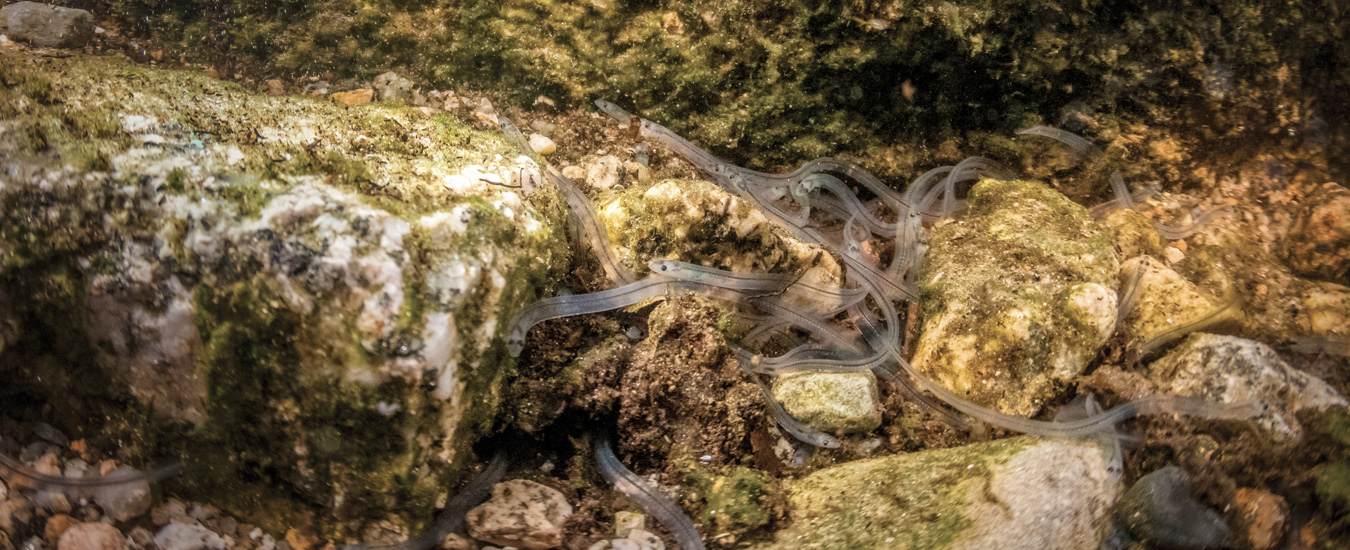Looking and feeling like a slimy snake tends to warp human opinion against the American eel, Anguilla rostrata. That impression changed abruptly when, as a teenager, I kept a young eel in an aquarium with other native fish over one summer. Other finny occupants hid upon my arrival, but the young eel quickly understood my food provisioning. Friendly, it would approach and enthusiastically lace its way through my submerged, outstretched fingers. I was hooked.
One of 18 members of the genus Anguilla found around the world, American eels populate eastern North America from southern Greenland to northern South America.
After hatching east of the Bahamas in the Sargasso Sea, small, transparent glass eels, shaped like willow leaves, drift on ocean currents until they reach our shores. There they transform into darker coloured elvers, adapting to freshwater. Eels don’t become males or females until they are 20 to 25 centimetres long. Living and maturing in estuaries, freshwater streams, rivers, and lakes for five to 20 years, mature adults can measure up to 130 centimetres long and weigh as much as 4.5 kilograms. Adults eventually return to the ocean, swimming back to the Sargasso Sea where they spawn, then die.
This life cycle varies. The average glass eel is about 2.5 centimetres long. On Jan. 31, 1930, the ship Dana, fishing between the Cape of Good Hope and Saint Helena Island at a depth of 70 metres, caught a glass eel that was 213 centimetres. Using the normal eel larva-adult size ratio, an adult would measure about 89 metres long.
Lifespans vary too. In 2016, I got a call from a gentleman named Roland, living in western Nova Scotia. He’d bought a house years earlier that had been vacant. Relatives mentioned at the time of sale that the former owner had placed an eel in the well to eat whatever fell in. Roland removed the well cover to check the water level. There, after 50 years, was a live eel. “How long can an eel live?” he asked.
Research led me to a glass eel named Putte, caught in 1863. Putte lived in an aquarium at the Museum of Helsingborg, Sweden, dying in 1948 at age 85. I suggested that Roland borrow an eel trap, catch and release the eel into the nearby Tusket River.
For centuries, the American eel fishery for Indigenous and settlers focused solely on spearing and trapping adult eels in fresh and coastal waters. Recently the hunt has changed to include young elvers, fresh from the sea and currently worth about $5,000 a kilogram to buyers from China. The Chinese raise elvers in captivity to sell as adults for food.
This Asian/American elver market arose after European and Japanese eel populations had declined drastically. Now American eel populations are disappearing. Sound familiar?

Decades ago, another fishery materialized. A burgeoning foreign market for herring eggs (called roe) resulted in the wholesale plundering of herring schools. Male and female bodies were discarded after eggs were removed. A vital component of ocean food chains was blatantly mined for quick money.
To paraphrase Dr. Wilfrid Creighton, a former forester, “The quickest way to harvest apples is to cut down the tree. But that may not be the wisest.”
Scientists estimate that in nature, the survival rate of elvers to adulthood is one per cent. The parasite Anguillicoloides crassus, which invades their gas bladder, has already compromised adult American eel stocks. This threat may be the result of importing infected Japanese eels for aquaculture purposes here. The parasite renders eels unfit for the long swim back to spawn in the Sargasso Sea.
Another issue is that internal organ disintegration and death, which usually occurs in the Sargasso Sea after spawning, is happening in North America, long before they reproduce, for causes scientists don’t yet understand.
Should money and demands from foreign markets be more important than sensible eel population management? The blatant greed of some elver fishers and the ineptitude of the federal fisheries department is a sad reflection on humankind.
Elver fishing is relatively new. It diminishes adult survival rates. To help any American eel population recovery, regulators should, in consultation with First Nation communities, work to protect Canadian elvers immediately. The most effective solution is likely a ban on catching them, with proper, effective enforcement and heavy fines for violations.
